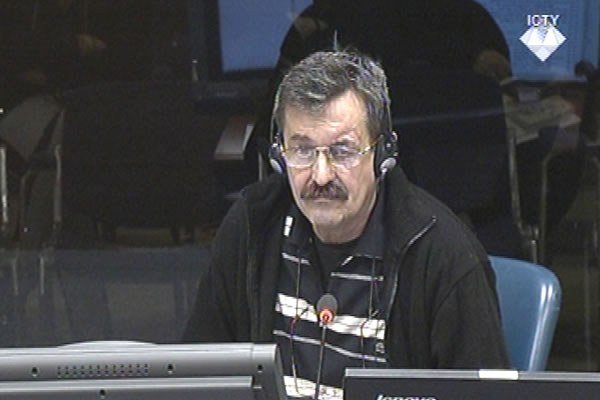Home
TRNOPOLJE – JOURNALISTS BEHIND FENCES, PRISONERS ROAM FREE
In a bid to prove that Trnopolje was not a prison camp but a collection center for civilians, Mladic’s defense witness Slavko Puhalic claimed that the wire seen in the footage made by the British TV network ITN crew in the summer of 1992 was there to fence in the journalists who were filming the camp. All of the persons tried for the Prijedor prison camps at the Tribunal in The Hague used the same argument in their defense, to no avail. Mladic left the courtroom before the end of the hearing because he was unwell
 Slavko Puhalic, defence witness at Rako Mladic trial
Slavko Puhalic, defence witness at Rako Mladic trial As alleged in the indictment against Ratko Mladic, Trnopolje was one of the prison camps where civilians from the Prijedor area were detained, starved, beaten, raped and killed. The defense, on the other side, argues that Trnopolje was a collection center where Muslim civilians were put in order to be kept safe from any attacks by out-of-control Serb groups. This is what Slavko Puhalic, Mladic’s defense witness, claimed too. During the war, the witness worked in Trnopolje as a driver, a logistics officer in charge of food and a ‘liaison between the people and the center warden’, Major Slobodan Kuruzovic.
In his statement to the defense, the witness said that no one was brought to Trnopolje by force. The people came in voluntarily; in fact, most of them drove in in their own cars, the witness explained. The goal of the exercise was to remove the people from combat zones and protect them. Puhalic argued that the Muslims could leave the center temporarily and go back to their homes provided they handed in their IDs to the guards. That, Puhalic noted, meant that Trnopolje was an ‘open-type’ center.
Defense counsel Branko Lukic played a well-known video made in the summer of 1992 by the British TV network ITN, led by journalist Penny Marshall. The footage shows Muslim men standing on one side of the barbed wire and fence. The journalists stood on the other side of the fence, asking questions.
The witness told the defense counsel that he remembered the location shown in the footage. Puhalic explained that the journalists stood in the yard of a shop selling agricultural tools, which was fenced off. The men from Trnopolje were free. The witness thus implied that the viewers were misled: the men from the collective center were not kept behind a wire fence, but were in fact completely free. This argument has already been used to no avail by various people from the Bosnian Serb political and police structures who have been tried for the crimes in the Prijedor prison camps.
The defense then played a recording of the Serb TV network taken that same day. In the footage, a journalist talks to the men standing behind (or in front of) a fence while guards in military uniforms can be seen inside the Trnopolje perimeter. Asked about the relationship between the guards and the people inside the collection center, Puhalic replied that the guards would mingle with the refugees and talk to them. Sometimes they would even share a glass of brandy, the witness noted. ‘There were no ugly scenes, there were some incidents from time to time, but mostly everything was quiet’, the witness described the situation in Trnopolje.
In the second part of the hearing, prosecutor Arthur Traldi began his cross-examination of Slavko Puhalic.
The accused Mladic was taken back to the Detention Unit today before the hearing ended because he was unwell. Mladic had previously given permission to his defense lawyers to proceed in his absence. During the final break today, Mladic complained he was not feeling well. The details were given to the judges in closed session. The trial continues on Monday.
Linked Reports
- Case : Mladic
- 2015-02-11 DR. DAVIDOVIC'S DIARY: 'EXPEL FOREVER'
- 2015-02-10 ‘VOLUNTARY’ PRISONERS IN PRIJEDOR PRISON CAMPS
- 2015-02-09 CONTESTING SREBRENICA PENITENT’S ‘ABSOLUTE UNTRUTHS’
- 2015-02-16 WERE PEOPLE BEATEN OR JUST PUSHED AROUND IN TRNOPOLJE?
- 2015-02-17 UNDER ‘UMBRELLA’ OF MANJACA
- 2015-02-18 ON THE EVE OF ATTACKS ON SREBRENICA AND ZEPA
